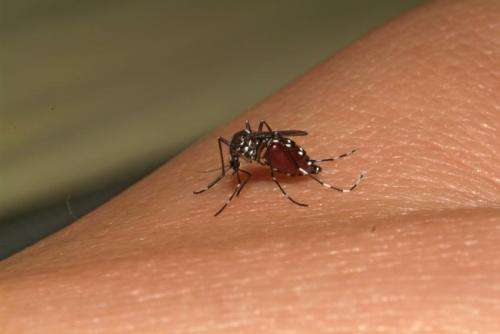This is Aedes albopictus during a blood-meal. Credit: Institut Pasteur
A team of French and Brazilian researchers warn that chikungunya virus is poised to invade, and become epidemic in the Americas according to research published ahead of print in the Journal of Virology.
The risk of a "catastrophic" epidemic in the Americas is boosted by the FIFA World Cup, to be held in Brazil next month, what with people coming in from near and from far, says corresponding author Ricardo Lourenco-de-Oliveira of the Instituto Oswaldo Cruz in Rio de Janeiro, Brazil. Brazil annually reports the highest incidence of dengue, a virus that is transmitted by Aedes aegypti and Aedes albopictus, the same mosquitoes that transmit chikungunya, he says.
The basis of his worries is the study, in which he and his collaborators compared the ability of 35 populations of the two Aedes species to transmit three different genotypes of chikungunya. These populations ranged all over the Americas from Buenos Aires to Tyson, Missouri (near St. Louis.) Even in temperate Missouri, A. albopictus was found to have a high dissemination and transmission ability for two of the three chikungunya genotypes.
Chikungunya can cause severe joint pain, which can sometimes lead to permanent disability, according to the US Centers for Disease Control and Prevention. Mortality has been known to reach 1/1000. The virus' name reflects the condition of many of the stricken, "bent down or become contorted," in the Tanzanian Makonda language.
Transmission of chikungunya was first reported in the Americas in December of last year, on the Caribbean island of St. Martin. By February 5th, the disease had spread to nine additional Caribbean countries. "The danger of chikungunya virus spreading all over the tropical, subtropical, and even temperate regions of the Americas is a risk greater than ever," says Lourenco-de-Oliveira. "Our results showed that the [Americas are] very receptive and vulnerable to CHIKV [chikungunya virus] transmission, and extremely exposed to the occurrence of an immediate chikungunya epidemic, since most regions are highly infested with both vectors."
More information: High vector competence of Aedes aegypti and Aedes albopictus from ten American 2 countries as a crucial factor of the spread of Chikungunya, Published ahead of print 26 March 2014, DOI: 10.1128/JVI.00370-14
Journal information: Journal of Virology
Provided by American Society for Microbiology




















